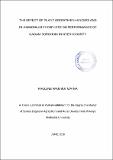| dc.description.abstract | Africa’s low agricultural productivity has many causes, including scarce and scant knowledge of improved practices, low use of improved seed, low fertilizer use, unfavorable weather conditions, inadequate irrigation, pests and diseases, conflict, absence of strong institutions, ineffective policies, and low and declining soil fertility. Kenya’s long-term vision is to transform into an industrialized middle income country by 2030. Agriculture plays a vital role in development and is often referred to as the backbone of the country’s economy and one of the primary causes of food and nutritional insecurity is low agricultural productivity. Humic substances are a category of naturally occurring organic compounds that arise from the decomposition and transformation of plant, animal, and microbial residues. Humic materials have been used in many ways for plant production. In this study, an experiment was conducted to examine the effects of plant growth enhancers on growth and grain yield of sorghum. The experiment was conducted at Wambugu Farm of Wambugu Agricutural Training Centre, Nyeri county using Gadam sorghum variety as the test-crop in a randomized complete block design (RCBD) with three replications during the short rain season of Oct-December 2013. Four levels of basal fertilizer (Di-Ammonium Phosphate) were applied at planting. Later in the season, two growth enhancers (Super Gro and Biodeposit Elixir) were used at three levels (25%, 50% & 100%) in the treatments and replicated three times with controls allowed at every fertilizer level. The treatments were applied three times on fortnightly basis (30/12/13; 13/11/14 & 27/2/14) i.e. during the growth stage and stopped at flowering. The results on plant height show p= 0.998 on the enhancers; p=0.730 from the fertilizer; and p=1 in the growth enhancers: fertilizer interaction. The results on flowering indicate p= 0.012 on the enhancers; p=0.0 from the fertilizer levels; and p=0.004 in the growth enhancers: fertilizer level interaction. A post hoc comparison to test for difference in means for different enhancers showed that the flowering was significantly affected at DAP levels of 25% (low fertility). The results on tillering, indicate p= 0.575 on the enhancers; p=0.855 from the fertilizer levels; and p=0.454 in the growth enhancers: fertilizer level interaction. The results on length of head, indicate p= 0.525 on the enhancers; p=0.3 from the fertilizer levels; and p=0.532 in the growth enhancers: fertilizer level interaction. The results on grain weight, indicate p= 0.752 on the enhancers; p=0.829 from the growth enhancers: fertilizer interaction; but p=0.000 from the fertilizer levels. The results of this study which show the growth enhancers had no significant difference on growth and yield of Gadam sorghum. The conclusion of the research is that use of growth enhancers on Gadam sorghum did not have any yield advantage but could enhance maturity and could therefore be useful with shortage of rains. This study does not recommend the use of either Super Gro or Biodeposit Elixir on Gadam sorghum. Further research on biostimulants is recommended to protect the farmers from unscrupulous traders. | en_US |

